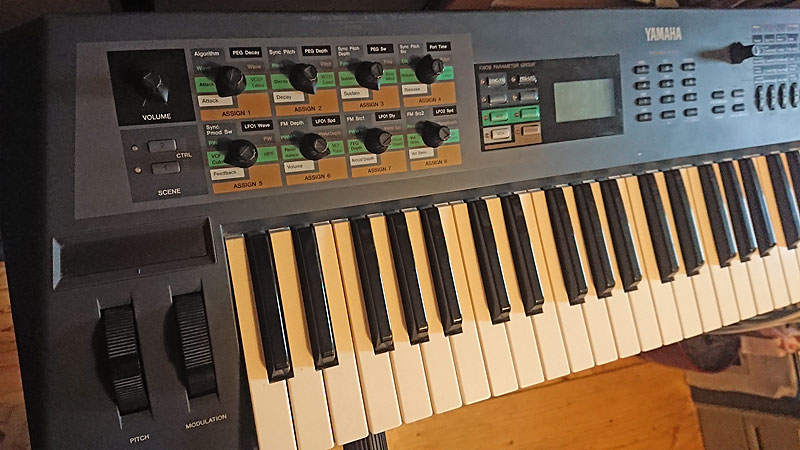
 |
start - maintenance - quick info - editor

Some internet quotes
Wikipedia: It has been noted that the firmware of the AN1x contains simulated characteristics of Sequential Circuits' Prophet 5 and particularly the Prophet 10 synthesizers, as well as Yamaha's own CS range of polyphonic analog synthesisers. Yamaha purchased the rights to Sequential Circuits in 1987, following the dissolution of the company. Sequential's founder, Dave Smith subsequently became President of DSD Inc., a research and development division of Yamaha. During his time at Yamaha, in addition to his work on vector and wavetable synthesis, which culminated in the SY22 and TG33, Smith also worked on physical modelling synthesis and software synthesizer concepts. Research that laid the foundations for the development of the AN1x.
Though containing more features than its contemporaries, the control interface of the AN1x initially proved frustrating for some users, due to its programming being matrix-based rather than one control per parameter like the Roland JP-8000. To counter these early misgivings, a sound set was released by Yamaha UK, called the London sound set, which contained clones of some of the JP-8000 presets. This helped to demonstrate the sound capabilities of the AN1x.
In 2000, Yamaha used the AN1x synthesis architecture to produce the PLG150-AN plugin board for the CS6x. The following year, Yamaha followed the AN1x with the AN200, a groovebox-type desktop sound module with half the polyphony of the AN1x.
Polynominal: TECH CPU HD6413002FP16 (family Renesas H8/300H) CPU manages 10 voices polyphony based on analog modeling APM subtractive synthesis.
Sound on Sound: While Yamaha can't actually label the PLG150-AN a 'Prophet 5 simulation', it's an open secret that the original AN1x has been re-voiced and re-tweaked in this new incarnation to make it sound as close as possible to this famous Sequential Circuits synth. The PLG150-AN, moreover, goes beyond the P5 by adding a whole range of extra FM possibilities.
I doubt the above statement from the Sound on Sound author, that the AN1x has been re-tweaked to the PLG-board.
There is a minimal difference between the AN1x synth and the PLG150-AN board.
See the JayB Youtube video "[Sound Comparison] Yamaha AN1x vs PLG150-AN".
Tips
The 'Free Envelope Generator' (Free EG)
is a powerful motion control feature that allows the user to record controller movements for up to four parameters, '4 tracks, 1 parameter per track' for a duration of up to 16 seconds each, or 8 bars that are tempo linked. Note: If the tempo is set to 40bpm, with a 4/4 count, this would result in 48 seconds of recording time per track. When applied to a voice, the Free EG becomes an intrinsic component of the voice whilst it is played, allowing for complex and evolving organic movement of sound. The way in which the Free EG loops can also be set in various ways, as well as the keyboard tracking and triggering. (Wikipedia)
Patches
kvraudio forum: elmosexwhistle: the sounds include patches which, using very clever mod sequencing of the noise amount, give you a complete bass and drum backing in the left hand and a poly part/lead in the right, there are also morphing patches, crazy free eg pads and other such things which push the an1x to it's total limits.
Matrixsynth: elmosexwhistle: hey fellow synth heads, on this here mp3 file you can hear what kind of sonic madness i've been creating with my an1x these past few months...interestingly there are no external effects (albeit a little treble added to brighten the sound slightly) and a little crossfading to shorten down the track...a load of patches are on this demo, includng melotrons, harpsichords, mad fm shiz and big lush pads...also alot of points where you'll be thinking *how the hell did he do that on a 4osc synth?* i don't even know myself sometimes
- search for the KoSMiX_AN1x archive on the Facebook AN1x channel.
VCA Feedback
Don't forget to use the "VCA Feedback" parameter, important for getting the best, most convincing analogue sound from the AN1x. Set it between 30-80 for most uses. (Facebook)
Sound on Sound: And it was only on modular synths that you could apply feedback from the output of the VCA back to the VCF input, which can provide a very nice low-end thickness or less immediately useful 'motor-boating' effects. The AN1x allows you to do this.
The ribbon controller is great for controlling the multi-mode filter, sync and detune settings.
And don't forget that 10-note polyphony is actually markedly better than 8-note polyphony for playing four-note chords because it allows you to accidentally overlap chords without note stealing.
The step sequencer provides those fixed or transposed 16-step sequences that I bopped to back in the '70s, and the arpeggiator provides bang up-to-date animation of block chords, with contorted timings, swing and gate lengths to play with, to make the result less predictable than boring clocked quarter notes. Using an arpeggiator live is expected, whereas step sequencers usually need setting up beforehand and merely play back live. But with the AN1x's eight front-panel knobs it's possible to control the notes, velocity, gate time and a MIDI Controller for all 16 (or less!) steps as the sequence plays. The arpeggiated notes and the Controller information all appear at the MIDI Out socket.